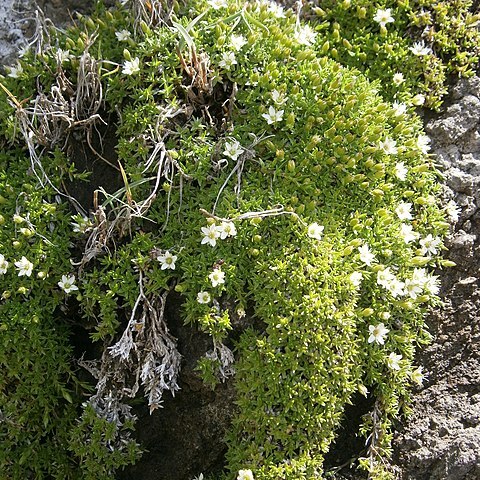Plants perennial, mat-forming. Taproots stout, woody. Stems suberect to ascending, green, 2-10-cm, retrorsely pubescent in lines, internodes of flowering stems 2-7 times as long as leaves. Leaves tightly overlapping or not (vegetative and proximal cauline) or variably spaced (distal cauline), usually connate proximally, with tight, scarious to herbaceous sheath 0.5-1 mm; blade straight to outwardly curved, green, flat, obscurely 1-veined abaxially, oblong or spatulate to elliptic, 5-10 × 0.7-2 mm, flexuous, margins not thickened, scarious, rarely ciliate proximally, apex green or purple, rounded, flat to navicular, shiny, glabrous; axillary leaves mostly absent. Inflorescences 3-5-flowered, open cymes; bracts lanceolate, herbaceous. Pedicels 0.5-1 cm, usually densely stipitate-glandular. Flowers: hypanthium cup-shaped; sepals 3-veined prominently in fruit, oblong to narrowly lanceolate (herbaceous portion often purple, oblong to narrowly oblanceolate), 3.5-4.5 mm, not enlarging in fruit, apex rarely purple, rounded, hooded (at least inner sepals) or not, glabrous to stipitate-glandular proximally; petals white or often lilac, broadly oblanceolate, 1.4-1.7 times as long as sepals, apex truncate, often shallowly notched. Capsules broadly ellipsoid, 5.5 mm, longer than sepals. Seeds brown, suborbiculate with radicle prolonged into beak, slightly compressed, 0.7-0.8 mm, smooth or obscurely scupltured (50×). 2n = 26.
More
Herbs perennial, 3--7 cm tall. Stems caespitose, erect, slender. Leaves linear, 6--10 × 0.5--1 mm, glabrous except for a few short cilia at base, apex acute. Flowers 1--3, terminal; pedicel 2--12 mm. Sepals ovate-oblong, 2.5--3.5 mm, 3-veined, apex obtuse. Petals white, oblong, subequaling sepals. Stamens 10; anthers yellow. Capsule yellow-green, ovoid, ca. 4 × 2.5 mm, slightly longer than sepals. Seeds reniform, 0.7--0.8 mm, smooth or rugose. Fl. Jun--Aug, fr. Aug--Sep.

